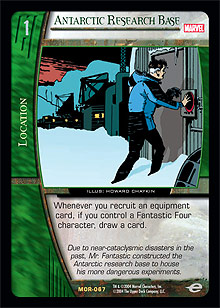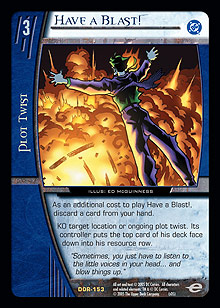
Here it is, my first article for Metagame.com, and as it happens to be Fantastic Four week, it’s probably a good time for it. I’d thought about writing on what makes a good deck or how to build a weenie deck that isn’t just a one trick pony, but in honor of Fantastic Four week, I’ve decided to give some insight into what makes Fantastic Fun work and what its issues are. Maybe some of you can even figure out a way to solve those issues. Let’s start off with a decklist:
Fantastic Fun
Characters
1 Frankie Raye
1 Wyatt Wingfoot
2 Ant Man
4 Invisible Woman, The Invisible Girl
4 Mr. Fantastic, Reed Richards
2 She-Thing
2 Thing, Ben Grimm
1 Human Torch, Hotshot
1 Invisible Woman, Sue Storm
2 Mr. Fantastic, Stretch
Plot Twists
1 Salvage
2 Thinking Outside the Box
4 Cosmic Radiation
4 A Child Named Valeria
3 Signal Flare
2 Have a Blast!
Locations
4 Antarctic Research Base
1 Pier 4
1 Baxter Building
Equipment
4 Unstable Molecules
4 Flamethrower
4 Advanced Hardware
2 Personal Force Field
2 The Pogo Plane
1 Fantasticar
1 War Wagon
So, why does Fantastic Fun work when so many other equipment and weenie decks fail?
There are three things that I believe make a deck strong—reliability, adaptability, and of course the all-important ability to do damage (or win in some other form). The Fantastic Four, along with some of their signature cards and equipment, can give you all three.
 Fantastic four has a lot of cards that can remove, and in fact reverse, the major disadvantage of equipment (the large reduction in hand size that translates into a reduction of both the reliability and adaptability of the deck). Mr. Fantastic, Reed Richards; Baxter Building; and most effectively, Antarctic Research Base each make the equipment a free card draw. With Antarctic Research Base and either of the other two cards, you get an additional card and can start to grow your hand size. This is one of the keys to how this deck works and gains as much flexibility as it does.
Fantastic four has a lot of cards that can remove, and in fact reverse, the major disadvantage of equipment (the large reduction in hand size that translates into a reduction of both the reliability and adaptability of the deck). Mr. Fantastic, Reed Richards; Baxter Building; and most effectively, Antarctic Research Base each make the equipment a free card draw. With Antarctic Research Base and either of the other two cards, you get an additional card and can start to grow your hand size. This is one of the keys to how this deck works and gains as much flexibility as it does.
I’m a big fan of card draw. It is one of the strongest effects in the game, and having a hand full of plot twists, character pumps, and alternative plays will make you far more likely to have whatever it is you need to react to what your opponent does and create a winning position. In addition to this simple card draw mechanism, Thinking Outside the Box (so obviously a Fantastic Four card, even if it isn’t specifically limited as one) allows your draw to become selective. It gives the aforementioned Baxter Building and Mr. Fantastic an additional use by allowing you to filter your cards and draw what you really need.
The real problem lies in setting up this combination of cards in one form or another. This is addressed by the wonderful search cards that Fantastic Four offers. The Pogo Plane will allow you to search for either of the locations, Mr. Fantastic and the Baxter Building will allow you to grab Pogo Planes, and Signal Flare will allow you to grab Mr. Fantastic. In addition, Antarctic Research Base gives you increased card draw that will help you to draw into whatever you need. In fact, the only part of this combo you don’t have an effective search engine for is Thinking Outside the Box.
That is not, however, the limit to this deck’s combos. In fact, almost every card in the deck is part of one combo or another, which is the key to its flexibility and adaptability. If your opponent stops it from drawing too many cards, it still has A Child Named Valeria and large stat pumps from its equipment, which allows it to be a combat deck. If your opponent is overly defensive, it has direct damage from the same equipment that will allow it to drain the opponent’s endurance regardless. If your opponent is overly offensive, Child can again be combined with reinforcement from the equipment to hold out while the opponent’s endurance is whittled away. If your opponent is playing a combo deck, life gets more interesting. Sometimes you can stop it with effects like Thing, Ben Grimm, stunning your opponent’s 1-drops. Sometimes you can simply kill him or her before the opposing combo goes off (this deck can kill on turn 4 or 5, but don’t count on regularly having enough damage until turn 6). This deck can also recover from a complete board-wiping disaster. With any Invisible Woman, any Mr. Fantastic, a couple of equipment that give reinforcement, and a single Child, you can hold off any amount of pure attack power (barring tricks) and get yourself back in the game.
So where does this deck go wrong?
 It has little room to adapt to the metagame. It has only two slots for cards with which to do so, and they are now filled with Have a Blast! (and are likely to stay that way). Because it is so short on characters (there are only 21), it requires a lot of equipment to function (currently there are eighteen) and contains a lot of key locations (six) and plot twists (thirteen). This means there isn’t much room for change . . . unless you think some of the cards are less vital than I do. Because of this, it can’t react well to faster combo decks.
It has little room to adapt to the metagame. It has only two slots for cards with which to do so, and they are now filled with Have a Blast! (and are likely to stay that way). Because it is so short on characters (there are only 21), it requires a lot of equipment to function (currently there are eighteen) and contains a lot of key locations (six) and plot twists (thirteen). This means there isn’t much room for change . . . unless you think some of the cards are less vital than I do. Because of this, it can’t react well to faster combo decks.
It is fairly reliable, though you have to count on one draw in ten being poor enough that you won’t be able to set up. This will happen either because of a simple lack of characters or equipment, or (most likely) because of a failure to get anything that helps you to set up the card draw combo. The odds of getting what you need are fairly high, but sometimes it just won’t happen, and because it has three different ways to fail, you have to expect that sometimes it will.
The deck also requires a lot of concentration and thinking ahead to play. I gave you a list of the many ways it can be played and how it can be adapted to what your opponent does. You have to think about this every game, as well as remember what cards have been placed on the bottom of your deck. You keep track so you know what you want to draw if you have Thinking Outside the Box or if you should use one of your shuffle effects before you draw.
 It starts failing as a combat deck around turn 6, and then your options become more and more limited, although a Thing with a pair of Flamethrowers (allowed by Pier 4) can still beat up most 6- and 7-drops. And don’t you just love the look on your opponent’s face when your 3-drop does that, especially if it can’t be stunned because of Child and proceeds to burn the opponent for 10 via a couple of Cosmic Radiations?
It starts failing as a combat deck around turn 6, and then your options become more and more limited, although a Thing with a pair of Flamethrowers (allowed by Pier 4) can still beat up most 6- and 7-drops. And don’t you just love the look on your opponent’s face when your 3-drop does that, especially if it can’t be stunned because of Child and proceeds to burn the opponent for 10 via a couple of Cosmic Radiations?
I love this deck and could keep talking about it (from why it isn’t as easy to counter as most people think, to why most of those counters don’t do as much as is believed, to why I use each of the characters I do, to why I tried combining it with Gotham Knights and how that failed), but I don’t want to bore you. So unless anyone wants to hear it, I’ll try to stick to more general deckbuilding strategies and maybe take a look at how to counter some of the powerhouse decks out there.
One last hint for playing Fun—protect your Childs. Sometimes it is preferable to lose a character you won’t really need later or can replace next turn in order to save a Child you may be desperate for later.
Good luck and have fun playing,
Dean